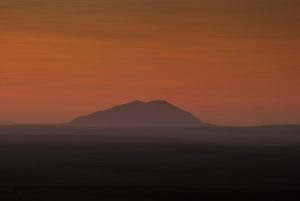Just a few miles west of here you will find the eastern boundary of a geologic province like no other. Most often referred to as the Snake River Plain, this unique landscape cuts a swath from the Oregon-Idaho-Nevada border all the way across Idaho to Yellowstone National Park. It is, in some respects, the deepest if not largest scar on the skin of planet Earth, having originated as it did from within, melting its way upward to the surface in northeasterly trending pulses of unimaginable violence over the last 16 million years.
What remains is a nearly 400 mile long and 50 to 70 mile wide swath of crust that has been chemically and physically altered to such an extent that is unrecognizable in the same general way that a child victim can often grow up to be an unrecognizable adult criminal. And here is the thing: the Snake River Plain is not just scar tissue. It is alive. While the North American plate (which is slowly drifting southwest) crosses over the top of the stationary Yellowstone hot spot, the silica-rich crust partially melts and thereby contributes the ingredients necessary for massive volcanic events. These super volcanic eruptions in the last 16.5 million years consume the original crust and leave behind a relatively lethargic slag of mafic rock. But it is hot rock. And while it might not produce super volcanic explosions, it produces surface lava flows far, far, far more often than the hot spot produces super volcanos.
The largest lava field in the Snake River Plain (and the largest of its kind in North America) is the Craters of the Moon Lava Field. This field alone, which is just one portion of the Snake River Plain, has experienced eight major eruption phases in the last 15 thousand years. Consisting of over 60 different lava flows, the 20 that have been dated reveal a 2,000 year average recurrence interval for eruptive activity. The last event was more than 2,000 years ago. It is entirely plausible to assert that we might be alive to witness the next one.
Doug Owens is a recently retired National Park Service geologist with a special appreciation for the forces that shaped Craters of the Moon National monument, the dynamic system that it is today, and how it is related to Yellowstone. This Tuesday, (November 15th) at the Teton County Library Auditorium at 6:00 pm, he will be here to share his excitement and knowledge about this amazing wonder just next door to Western Wyoming.

